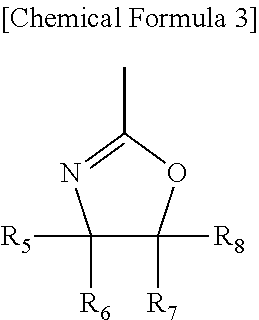Aqueous coating composition and method for forming multilayer coating film
a coating composition and multi-layer technology, applied in the direction of coatings, coatings, chemical instruments and processes, etc., can solve the problems of unsatisfactory finishing appearance of the resulting coating film, environmental concerns have become global issues, and the aqueous coating composition cannot assure a satisfactory finishing appearance. , to achieve the effect of superior coating film appearance, superior viscosity behavior, and superior finishing appearan
- Summary
- Abstract
- Description
- Claims
- Application Information
AI Technical Summary
Benefits of technology
Problems solved by technology
Method used
Image
Examples
examples
[0267]The following more specifically describes the present invention with reference to some Production Examples, Examples and Comparative Examples.
[0268]The present invention is however not limited to those Examples.
[0269]In the following, “part” and “%” denote “part by mass” and “percentage by mass”. The film thickness of the coating film denotes the thickness of a cured coating film.
Production of Polyester Resin (A)
production examples 1 to 17
[0270]According to the ratios shown in FIG. 1, 17 samples of an acid / alcohol mixture were prepared. Each sample was placed in a four-neck flask having a heating unit, a stirrer, a thermometer, a reflux condenser and a distillation column. The mixture was first heated to 160° C. and then further heated from 160° C. to 230° C. for three hours while distilling out the condensed water using the distillation column. Thereafter, the mixture was reacted at 230° C. for 2 hours.
[0271]In FIG. 1, “(a-1)+(a-2)(wt %)” denotes the total content (mass %) of the straight-chain dicarboxylic acid (a-1) having a carbon number of 8 or more, and the straight-chain diol (a-2) having a carbon number of 8 or more, based on the gross amount of the alcohol component and the acid component.
[0272]Next, the distillation column was replaced with a water separator. Toluene was added to the reaction product as required. The mixture was kept under reflux at 230° C. and the condensation water was separated and disti...
example 18
[0280]420 parts of polyethylene glycol 6000 (molecular weight=6,000) and 177 parts of polyether monol obtained by adding 20 mol of ethylene oxide to cholesterin were placed in a 1000 ml four-neck flask having a heating unit, a thermometer, a nitrogen introducing tube and a high-viscosity stirrer. The mixture was subjected to a dehydration reaction under reduced pressure (5 to 10 mmHg) at 80 to 90° C. for 3 hours to adjust the moisture content of the system to 0.03%. Subsequently, the reaction product was cooled to 70° C., and 23.5 parts of hexamethylene diisocyanate were added. The obtained mixture was reacted at 85 to 90° C. under nitrogen stream until the isocyanate content tracked by IR became substantially 0% (3 hours), thereby obtaining a thickener (C-1) in which X and Z in Formula (1) are each a cholesteryl group, Y is a hexamethylene group, each of OR, OR′, and OR″ is an oxyethylene group, and a, b, c and d are 20, 136, 1, and 20, respectively.
PUM
| Property | Measurement | Unit |
|---|---|---|
| acid value | aaaaa | aaaaa |
| acid value | aaaaa | aaaaa |
| mass % | aaaaa | aaaaa |
Abstract
Description
Claims
Application Information
 Login to View More
Login to View More - R&D
- Intellectual Property
- Life Sciences
- Materials
- Tech Scout
- Unparalleled Data Quality
- Higher Quality Content
- 60% Fewer Hallucinations
Browse by: Latest US Patents, China's latest patents, Technical Efficacy Thesaurus, Application Domain, Technology Topic, Popular Technical Reports.
© 2025 PatSnap. All rights reserved.Legal|Privacy policy|Modern Slavery Act Transparency Statement|Sitemap|About US| Contact US: help@patsnap.com



